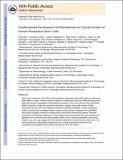| dc.contributor.author | Mei, Ying | |
| dc.contributor.author | Saha, Krishanu | |
| dc.contributor.author | Bogatyrev, Said R. | |
| dc.contributor.author | Yang, Jing | |
| dc.contributor.author | Hook, Andrew L. | |
| dc.contributor.author | Kalcioglu, Zeynep Ilke | |
| dc.contributor.author | Cho, Seung Woo | |
| dc.contributor.author | Mitalipova, Maisam | |
| dc.contributor.author | Pyzocha, Neena | |
| dc.contributor.author | Rojas, Fredrick P. | |
| dc.contributor.author | Van Vliet, Krystyn J. | |
| dc.contributor.author | Davies, Martyn C. | |
| dc.contributor.author | Alexander, Morgan R. | |
| dc.contributor.author | Langer, Robert | |
| dc.contributor.author | Jaenisch, Rudolf | |
| dc.contributor.author | Anderson, Daniel G. | |
| dc.date.accessioned | 2012-10-15T17:52:31Z | |
| dc.date.available | 2012-10-15T17:52:31Z | |
| dc.date.issued | 2010-08 | |
| dc.date.submitted | 2009-09 | |
| dc.identifier.issn | 1476-1122 | |
| dc.identifier.issn | 1476-4660 | |
| dc.identifier.uri | http://hdl.handle.net/1721.1/73981 | |
| dc.description | July 3, 2012 | en_US |
| dc.description.abstract | Both human embryonic stem cells and induced pluripotent stem cells can self-renew indefinitely in culture; however, present methods to clonally grow them are inefficient and poorly defined for genetic manipulation and therapeutic purposes. Here we develop the first chemically defined, xeno-free, feeder-free synthetic substrates to support robust self-renewal of fully dissociated human embryonic stem and induced pluripotent stem cells. Material properties including wettability, surface topography, surface chemistry and indentation elastic modulus of all polymeric substrates were quantified using high-throughput methods to develop structure–function relationships between material properties and biological performance. These analyses show that optimal human embryonic stem cell substrates are generated from monomers with high acrylate content, have a moderate wettability and employ integrin α[subscript v]β[subscript 3] and α[subscript v]β[subscript 5] engagement with adsorbed vitronectin to promote colony formation. The structure–function methodology employed herein provides a general framework for the combinatorial development of synthetic substrates for stem cell culture. | en_US |
| dc.description.sponsorship | National Institutes of Health (U.S.) (Grant R37-CA084198) | en_US |
| dc.description.sponsorship | National Institutes of Health (U.S.) (Grant RO1-CA087869) | en_US |
| dc.description.sponsorship | National Institutes of Health (U.S.) (Grant RO1-HD045022) | en_US |
| dc.description.sponsorship | National Institutes of Health (U.S.) (Grant DE016516) | en_US |
| dc.description.sponsorship | Massachusetts Institute of Technology. Institute for Soldier Nanotechnologies (Contract W911NF-07-D-0004) | en_US |
| dc.language.iso | en_US | |
| dc.publisher | Nature Publishing Group | en_US |
| dc.relation.isversionof | http://dx.doi.org/10.1038/nmat2812 | en_US |
| dc.rights | Article is made available in accordance with the publisher's policy and may be subject to US copyright law. Please refer to the publisher's site for terms of use. | en_US |
| dc.source | PMC | en_US |
| dc.title | Combinatorial Development of Biomaterials for Clonal Growth of Human Pluripotent Stem Cells | en_US |
| dc.type | Article | en_US |
| dc.identifier.citation | Mei, Ying et al. “Combinatorial Development of Biomaterials for Clonal Growth of Human Pluripotent Stem Cells.” Nature Materials 9.9 (2010): 768–778. | en_US |
| dc.contributor.department | Harvard University--MIT Division of Health Sciences and Technology | en_US |
| dc.contributor.department | Massachusetts Institute of Technology. Department of Biology | en_US |
| dc.contributor.department | Massachusetts Institute of Technology. Department of Chemical Engineering | en_US |
| dc.contributor.department | Massachusetts Institute of Technology. Department of Materials Science and Engineering | en_US |
| dc.contributor.department | Koch Institute for Integrative Cancer Research at MIT | en_US |
| dc.contributor.mitauthor | Mei, Ying | |
| dc.contributor.mitauthor | Bogatyrev, Said R. | |
| dc.contributor.mitauthor | Kalcioglu, Zeynep Ilke | |
| dc.contributor.mitauthor | Cho, Seung Woo | |
| dc.contributor.mitauthor | Pyzocha, Neena | |
| dc.contributor.mitauthor | Rojas, Fredrick P. | |
| dc.contributor.mitauthor | Van Vliet, Krystyn J. | |
| dc.contributor.mitauthor | Langer, Robert | |
| dc.contributor.mitauthor | Jaenisch, Rudolf | |
| dc.contributor.mitauthor | Anderson, Daniel G. | |
| dc.relation.journal | Nature Materials | en_US |
| dc.eprint.version | Author's final manuscript | en_US |
| dc.type.uri | http://purl.org/eprint/type/JournalArticle | en_US |
| eprint.status | http://purl.org/eprint/status/PeerReviewed | en_US |
| dspace.orderedauthors | Mei, Ying; Saha, Krishanu; Bogatyrev, Said R.; Yang, Jing; Hook, Andrew L.; Kalcioglu, Z. Ilke; Cho, Seung-Woo; Mitalipova, Maisam; Pyzocha, Neena; Rojas, Fredrick; Van Vliet, Krystyn J.; Davies, Martyn C.; Alexander, Morgan R.; Langer, Robert; Jaenisch, Rudolf; Anderson, Daniel G. | en |
| dc.identifier.orcid | https://orcid.org/0000-0003-3310-6277 | |
| dc.identifier.orcid | https://orcid.org/0000-0001-5735-0560 | |
| dc.identifier.orcid | https://orcid.org/0000-0001-5629-4798 | |
| dc.identifier.orcid | https://orcid.org/0000-0003-4255-0492 | |
| dspace.mitauthor.error | true | |
| mit.license | PUBLISHER_POLICY | en_US |
| mit.metadata.status | Complete | |
